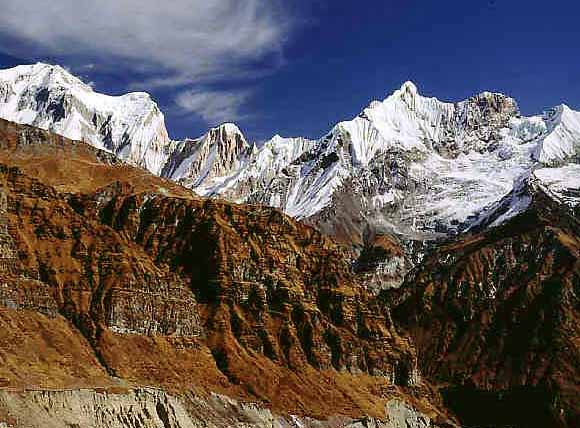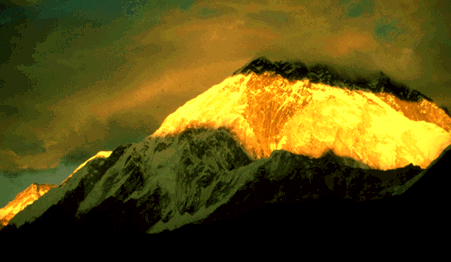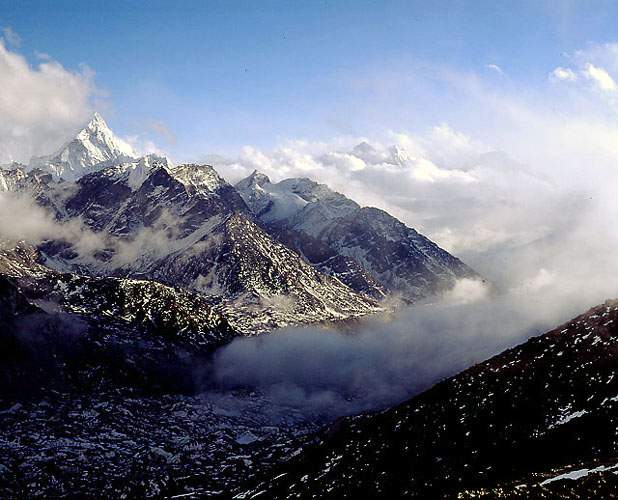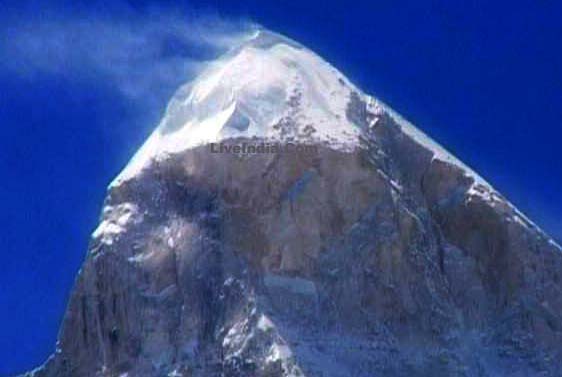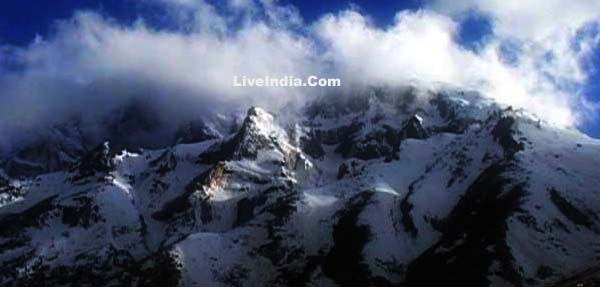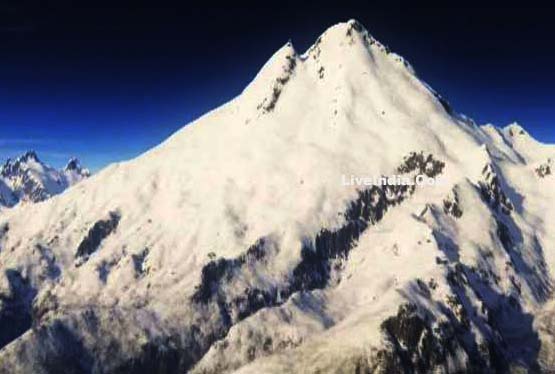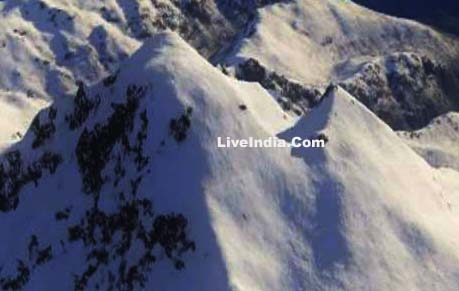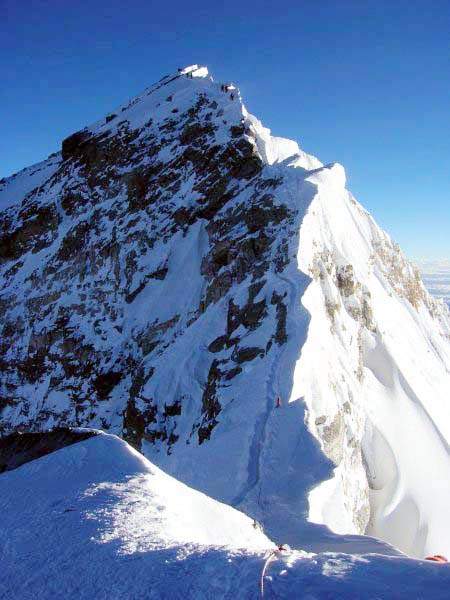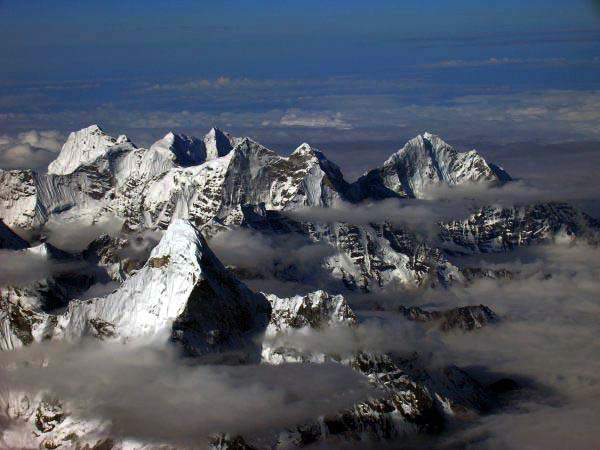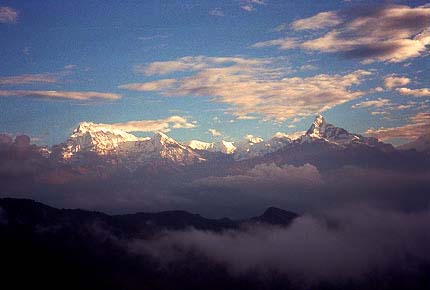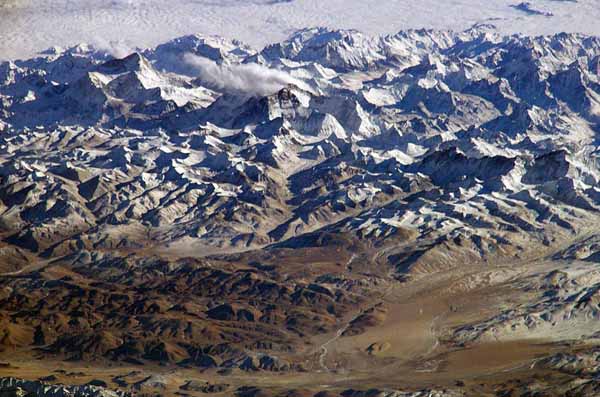
The Himalayas: Two continents collide Among the most dramatic and visible creations of plate-tectonic forces are the lofty Himalayas, which stretch 2,900 km along the border between India and Tibet. This immense mountain range began to form between 40 and 50 million years ago, when two large landmasses, India and Eurasia, driven by plate movement, collided. Because both these continental landmasses have about the same rock density, one plate could not be subducted under the other. The pressure of the impinging plates could only be relieved by thrusting skyward, contorting the collision zone, and forming the jagged Himalayan peaks. About 225 million years ago, India was a large island still situated off the Australian coast, and a vast ocean (called Tethys Sea) separated India from the Asian continent. When Pangaea broke apart about 200 million years ago, India began to forge northward. By studying the history -- and ultimately the closing-- of the Tethys, scientists have reconstructed India's northward journey. About 80 million years ago, India was located roughly 6,400 km south of the Asian continent, moving northward at a rate of about 9 m a century. When India rammed into Asia about 40 to 50 million years ago, its northward advance slowed by about half. The collision and associated decrease in the rate of plate movement are interpreted to mark the beginning of the rapid uplift of the Himalayas The 6,000-km-plus journey of the India landmass (Indian Plate) before its collision with Asia (Eurasian Plate) about 40 to 50 million years ago (see text). India was once situated well south of the Equator, near the continent of Australia. The Himalayas and the Tibetan Plateau to the north have risen very rapidly. In just 50 million years, peaks such as Mt. Everest have risen to heights of more than 9 km. The impinging of the two landmasses has yet to end. The Himalayas continue to rise more than 1 cm a year -- a growth rate of 10 km in a million years! If that is so, why aren't the Himalayas even higher? Scientists believe that the Eurasian Plate may now be stretching out rather than thrusting up, and such stretching would result in some subsidence due to gravity
Fifty kilometers north of Lhasa (the capital of Tibet), scientists found layers of pink sandstone containing grains of magnetic minerals (magnetite) that have recorded the pattern of the Earth's flip-flopping magnetic field. These sandstones also contain plant and animal fossils that were deposited when the Tethys Sea periodically flooded the region. The study of these fossils has revealed not only their geologic age but also the type of environment and climate in which they formed. For example, such studies indicate that the fossils lived under a relatively mild, wet environment about 105 million years ago, when Tibet was closer to the equator. Today, Tibet's climate is much more arid, reflecting the region's uplift and northward shift of nearly 2,000 km. Fossils found in the sandstone layers offer dramatic evidence of the climate change in the Tibetan region due to plate movement over the past 100 million years. At present, the movement of India continues to put enormous pressure on the Asian continent, and Tibet in turn presses on the landmass to the north that is hemming it in. The net effect of plate-tectonics forces acting on this geologically complicated region is to squeeze parts of Asia eastward toward the Pacific Ocean. One serious consequence of these processes is a deadly "domino" effect: tremendous stresses build up within the Earth's crust, which are relieved periodically by earthquakes along the numerous faults that scar the landscape. Some of the world's most destructive earthquakes in history are related to continuing tectonic processes that began some 50 million years ago when the Indian and Eurasian continents first met. |
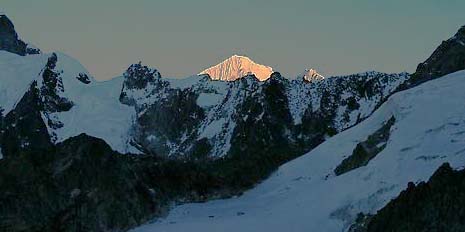
The Himalaya is a mountain range in Asia, separating the Indian subcontinent from the Tibetan Plateau. By extension, it is also the name of the massive mountain system which includes the Himalaya proper, the Karakoram, the Hindu Kush, and a host of minor ranges extending from the Pamir Knot. The name is from Sanskrit himalaya, a tatpurusa compound meaning "the abode of snow" (from hima "snow", and alaya "abode"; see also Himavat). Together, the Himalaya mountain system is the planet's highest and home to all fourteen of the world's highest peaks: the Eight-thousanders, including Mount Everest. To comprehend the enormous scale of Himalaya peaks, consider that Aconcagua, in the Andes, at 6,962 m, is the highest peak outside the Himalaya, while the Himalaya system has over 100 separate mountains exceeding 7,200 m. The Himalaya stretches across five nations: Bhutan, China, India, Nepal, and Pakistan. It is the source of three of the world's major river systems, the Indus Basin, the Ganga-Brahmaputra Basin and the Yangtze Basin. An estimated 750 million people live in the watershed area of the Himalayan rivers, which also includes Bangladesh
--------
The Indian Himalayas
The arc-shaped Himalayas extend along the entire northern boundary of India and carve just as far across the Indian subcontinent as they do deeply into the life around them. The term "Himalaya" -- a Sanskrit word meaning "the Abode of Snow" -- was coined by the Indian pilgrims who traveled in these mountains in ancient times. For centuries, the inhabitants of India have been fascinated by this mountain chain. The feeling is a mixture of admiration, awe and fear; and for the Hindus of India, the Himalayas are also "the Abode of God". There are numerous pilgrim routes that have brought the Hindu pilgrims to these mountains since time immemorial. The Indian Himalayas cover a vast area along the northern frontiers of the country and span five Indian States -- Jammu and Kashmir , Himachal Pradesh, Uttar Pradesh, Sikkim and Arunachal Pradesh -- from west to east. For the mountain people living in these states, the Himalayas continue to be the predominant factor in their lives. Having acted as a natural and political barrier for centuries, the Himalayas have isolated a number of communities, cultures and customs. The Indian Himalayas mark the crossroads of Asia's three main religions. Kashmir -- formerly a paradise on earth -- is largely influenced by Islam and Hinduism(Kahmiri Pandits). The foothills of Jammu, Himachal Pradesh and Uttar Pradesh form the northern boundary of Hinduism. The entire Trans Himalayan region, from Ladakh (Jammu and Kashmir) through Tibet and onto the eastern state of Sikkim, has seen a dominating influence of Buddhism. The true divisions of the Indian Himalayas are based on the mountain ranges rather than the state boundaries. From west to east, the Indian Himalayas can be divided into: Nepal Himalayas
General info
Containing nine of the world's fourteen highest mountain peaks, Nepal is a true Himalayan kingdom. The Himalayas cover three fourths of the land in Nepal. It is home to some of the highest, remotest, most rugged and most difficult terrain in the world. The loftiest peak in the world -- Mount Everest -- and other high peaks like Lhotse, Nuptse, Annapurna, Dhaulagiri and Manaslu, plus the presence of some exquisitely beautiful trekking routes, attract hundreds of thousands of people from all over the world to this lovely Himalayan destination.
The country of Nepal can be divided into three parallel bands running from the northeast towards the southwest. Along the north of Nepal runs the Great Himalayan Range, the highest mountain range in the Himalayan system. This range has an average altitude of about 4,570 m (about 15,000 ft) and remains perpetually snow-covered. On this range rise some of the loftiest mountain peaks in the world -- Mount Everest, Kanchenjunga, Lhotse, Makalu, Cho Oyu, Dhaulagiri, Manaslu, and Annapurna. Further south runs a complex system of intermediate ranges at an altitude of 8,000-14,000 ft. Prominent ranges in this mountain system include the Mahabharat and Churia ranges. High mountain ranges are interspersed with broad inhabited river valleys. The third and southernmost region is the Terai, a swampy terrain which is the northern extension of the Indian plains.
Tibetan Himalayas
General info
Tibet is situated on the Qingzang (Qinghai-Tibet) Plateau. This is the highest plateau in the world with an average elevation of 4,875 m (more than 16,000 ft), and the Tibetan Plateau is also called the Roof of the World. In 1964, Tibet became an Autonomous Region of China. It is surrounded in the north and east by other provinces of China, in the south and west by Burma, India, Bhutan, and Nepal. The capital of Tibet is Lhasa.
Tibet is surrounded on three sides by vast mountain systems: the Kunlun mountains of Central Asia in the north, the Karakoram range in the west and the Himalayas in the south Trans Himalayas
Tibet lies in a region known as Trans Himalayas. As the term suggests, Tibet lies beyond the main Himalayan range. The Trans Himalayan region itself is an ill-defined mountain region covering an area of about 1,000 km (600 miles) and having a width ranging from 225 km (140 miles) to about 32 km (20 miles). Unlike the main Himalayas, the Trans Himalayan mountains are not divided by deep river gorges. On the Roof of the World, passes average 5,330 m (17,500 ft) in height, with the highest being the Chargoding Pass at a height of 5,885 m (19,308 ft).The first recorded European exploration of the Trans Himalayas was carried out by the Swedish explorer Sven Hedin. Hedin explored Tibet and the Xinjiang (Sinkiang) region extensively. He identified the sources of the Brahmaputra, Indus, and Satluj rivers, and, in 1906, explored and named the Kailas Range The southern part of Tibet falls within the Himalayan region. Some of the world's highest mountains define the southern border of Tibet. These include Mt Everest (8,848 m) -- the highest mountain in the world, Namcha Barwa (7,756 m / 25,445 ft) -- around which the Brahmaputra carves a fantastic gorge to enter India, and Gurla Mandhata (7,728 m / 25,355 ft). Running north of the main Himalayan range is the Kailas Range, named thus by Hedin.Between the two ranges lies the river valley region extending for about 1,000 km from west to east. The Brahmaputra River (known in Tibet as the Yarlung Tsangpo) flows from west to east through most of this region. The Tibetan plateau is the source of some of the biggest rivers in the Himalayas. The Brahmaputra, Indus and Satluj are three Trans Himalayan rivers that originate in Tibet, cut across the main Himalayas making fearsome gorges and then flow towards the plains. |







